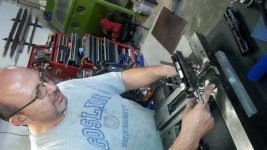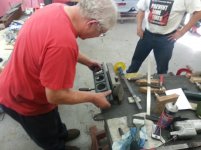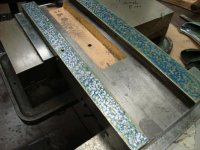Jashley73
Titanium
- Joined
- Jan 24, 2013
- Location
- Louisville, KY
So at work, our "tool-room" lathe is a four-letter-word, Chinese made, mail order special, and it needs some love. Today while working on it, one of my guys was oiling the cross-slide, and fed the cross-slide too far and disengaged one of the double-nuts for the X-axis leadscrew, and didn't know what was going on.
No big deal - so we pull the cross-slide off so I can show him how it's all put back together, and how to adjust out the backlash etc... While checking it out, we noticed that the cross-slide ways are scored on both the carriage side, and the cross-slide itself. After some aggressive stoning, I had an "idear"...
I've been reading about scraping for a while now, and have toyed around on some scrap, and I figured that today we had the time, and the lathe needs the love, so what the heck, let's scrape it...
This was probably 40-minutes of scraping after the initial stoning.



I'm sure to most of you this looks like garbage, and if you watched my technique you'd probably want to vomit and then pull out your hair in disgust, but the end result was a big improvement.
The tools used: I'm using oil-paint from a craft store for spotting, the scraper is made from an old file, and a cut-up broom handle, and the straight-edge is a 15" Starret .0005"/grad level that I saved from the scrap dumpster. The Starret level is hand-scraped on its sole, and when spot-checking it on a granite surface plate, it checks flat, and even across the sole, save the middle 1/3 is relieved. I assume it's relieved in the middle so that as a level, it will sit firmly on the ends, and not rock on the center.
As for the lathe - we noticed much smoother travel when feeding the cross-slide now. I should have taken pictures of the initial spotting for comparison. I'd still like to pull it apart and again, and try for more uniform contact across the entire carriage way surfaces, and then grind the cross-slide way surfaces. The cross-slide surfaces (not shown) are pitiful - they definitely need attention. I'd also like to remove the tailstock and run the carriage all the way back, and then pull the lathe away from the wall and stand on some pallets so I have more room to scrape from both sides, at a more comfortable height. I do have some questions however...
-After grinding the mating way surface (bottom of cross-slide), should I scrape/flake that surface too, or just leave the grind finish?
-What about the gib? The current gib looks curved like a banana. Is this normal - is it supposed to be sprung in order to make contact at both ends against the outer dovetail face? Or is it supposed to be straight, and typical 50% contact?
Anyway, thanks for reading. I just wanted to share.
No big deal - so we pull the cross-slide off so I can show him how it's all put back together, and how to adjust out the backlash etc... While checking it out, we noticed that the cross-slide ways are scored on both the carriage side, and the cross-slide itself. After some aggressive stoning, I had an "idear"...
I've been reading about scraping for a while now, and have toyed around on some scrap, and I figured that today we had the time, and the lathe needs the love, so what the heck, let's scrape it...
This was probably 40-minutes of scraping after the initial stoning.



I'm sure to most of you this looks like garbage, and if you watched my technique you'd probably want to vomit and then pull out your hair in disgust, but the end result was a big improvement.
The tools used: I'm using oil-paint from a craft store for spotting, the scraper is made from an old file, and a cut-up broom handle, and the straight-edge is a 15" Starret .0005"/grad level that I saved from the scrap dumpster. The Starret level is hand-scraped on its sole, and when spot-checking it on a granite surface plate, it checks flat, and even across the sole, save the middle 1/3 is relieved. I assume it's relieved in the middle so that as a level, it will sit firmly on the ends, and not rock on the center.
As for the lathe - we noticed much smoother travel when feeding the cross-slide now. I should have taken pictures of the initial spotting for comparison. I'd still like to pull it apart and again, and try for more uniform contact across the entire carriage way surfaces, and then grind the cross-slide way surfaces. The cross-slide surfaces (not shown) are pitiful - they definitely need attention. I'd also like to remove the tailstock and run the carriage all the way back, and then pull the lathe away from the wall and stand on some pallets so I have more room to scrape from both sides, at a more comfortable height. I do have some questions however...
-After grinding the mating way surface (bottom of cross-slide), should I scrape/flake that surface too, or just leave the grind finish?
-What about the gib? The current gib looks curved like a banana. Is this normal - is it supposed to be sprung in order to make contact at both ends against the outer dovetail face? Or is it supposed to be straight, and typical 50% contact?
Anyway, thanks for reading. I just wanted to share.
Last edited:








